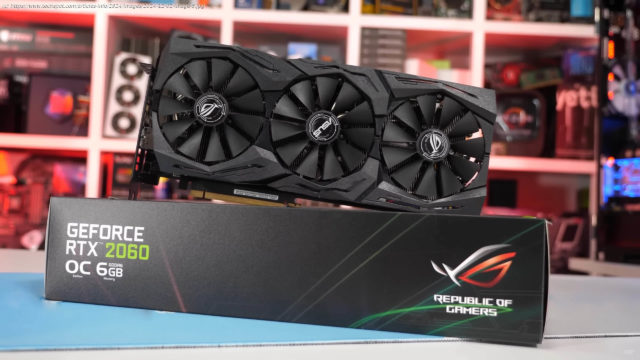We revisit the GeForce RTX 2060 and Nvidia’s promise of ray tracing from its base GPU some 6 years ago. Did this $350 GPU deliver on its potential?
After our recent extensive investigation into ray tracing game performance, where we analyzed its visual and performance impact across 36 modern games, we can continue exploring the real-world experience on existing products.
Today, we’ll be revisiting ray tracing on the most affordable GPU from the initial Nvidia RTX launch – the card Nvidia promised would bring ray tracing to mid-range gamers: the GeForce RTX 2060. How well has this card stood the test of time, and did Nvidia actually deliver something useful with this GPU’s ray tracing capabilities? Well… it’s time to find out.
This is all part of our goal to better understand ray tracing as we approach a brand new generation of graphics cards, expected to launch in early 2025. What are the best games to test? How many games provide a worthwhile ray tracing experience? How important is this feature as part of a GPU package?
And crucially, for this revisit of the RTX 2060: what have gamers been sold up to this point? What baseline can we use to benchmark improvements, especially in the mainstream market?
Looking at the RTX 2060 is quite a contrast to our previous RT exploration of Nvidia and AMD’s high-end GPUs and the best experiences available today. When the RTX 2060 launched in early 2019, it was a mid-range GPU priced at $350, the lowest model in the new RTX product stack to support ray tracing.
A direct replacement for the GTX 1070 in terms of price, the key feature Nvidia pushed with the 2060 was ray tracing: get this card instead of a GeForce 10 series GPU because it supports RTX features, including ray tracing and DLSS.
The first version of DLSS was a colossal flop back then, but over the years it has developed into a worthwhile feature. Gamers who bought a 2060 for DLSS have seen that experience improve significantly. Can the same be said for ray tracing, more than five years after the card debuted?
It’s important to first set the stage for what the RTX 2060 represented at launch. As a mid-range graphics card, it was positioned for 1440p 60 FPS gaming at ultra settings, and that’s certainly what we observed in our initial review.
We tested a variety of games at 1440p and found the 2060 was a decently capable 1440p GPU, with most games playable at 60 FPS.
Steve called it the best value mid-range GPU at the time but also expressed disappointment with the bang for buck it offered. It didn’t provide significantly better cost per frame than the GTX 1070, despite being part of an entirely new generation, and it didn’t advance the mid-range all that much.
Given that the card was just 10 – 15% faster than the GTX 1070 at launch, our opinion at the time was that Nvidia were attempting two things: one, to sell gamers on RTX features like ray tracing and DLSS instead of raw performance improvements, and two, to increase GPU prices overall and elevate the mid-range in response to gamers buying more expensive graphics cards.
The 2060 wasn’t as egregious as models like the RTX 2070 and RTX 2080, but Nvidia was clearly focused on selling gamers future promises rather than current capabilities.
And now the future is here, so it’s time to assess how the RTX 2060 has aged and whether those promises have been fulfilled. When we initially planned this revisit, our goal was to examine the 2060 at the resolution it was designed for at launch: 1440p. However, after some testing, it’s evident that the RTX 2060 hasn’t aged well for 1440p gaming, even without ray tracing enabled.
With just 6GB of VRAM, many modern titles encounter VRAM-related issues at 1440p. As is to be expected, about six years after its debut, the RTX 2060 is no longer delivering mid-range performance. These days, the 2060 is more akin to an entry-level 1080p GPU. It’s generally a bit slower than the Radeon RX 6600, and it seems likely that gamers who bought a 2060 for 1440p gaming have since upgraded to newer cards like the RTX 4060.
This revisit is now focused on 1080p and whether the RTX 2060 can handle decent-quality ray tracing effects at all – and you’ll see why this approach makes sense in the performance charts. We’re focusing on games where ray tracing is worth using, along with a couple of new additions, including titles that rely entirely on ray tracing, like Star Wars Outlaws. Let’s get into it.
We’ll start with Ratchet & Clank: Rift Apart at 1080p max settings with DLSS Quality enabled. This game is a real struggle for the RTX 2060, even without ray tracing enabled, managing just 43 FPS on average, with 1% lows dropping below 30 FPS.
Turning on ray tracing is simply not an option, as it lowers the frame rate to below 30 FPS on average, even at lower quality settings.
Something we often hear when discussing ray tracing is the idea that mid-range gamers could theoretically use ray tracing with lower overall quality presets. Instead of running ultra presets with ray tracing, the suggestion is to use medium or low presets combined with ray tracing.
We’re not advocating this as a sensible configuration, since the overall visual quality of low settings with ray tracing is usually worse than running ultra settings without ray tracing. However, when ray tracing configurations struggle to hit 30 FPS at 1080p, even with upscaling enabled, we feel it’s worth asking whether there’s any configuration where ray tracing is usable at all.
And so for Ratchet and Clank, along with all other games, we’ve tried to lower settings until ray tracing is potentially usable to see what we’re working with. In other words, how compromised the experience gets to use RT on an RTX 2060.
We’ve tried to lower settings until ray tracing is potentially usable to see what we’re working with. In other words, how compromised the experience gets to use RT on an RTX 2060 today.
With Ratchet & Clank, it’s clear that ray tracing is simply not viable on the RTX 2060. Even using Very Low settings with upscaling, enabling ray tracing results in a 40% performance hit, dropping a modest 80 FPS output (not impressive for very low settings) down to just 48 FPS on average. For those aiming for the highest quality effects that minimize visual artifacts, the experience is further reduced to 44 FPS.
In contrast, Guardians of the Galaxy is playable with ray tracing enabled on the RTX 2060. Rasterized performance using max settings and DLSS upscaling exceeds 100 FPS in the area we tested.
Enabling RT reflections reduces performance but still maintains a frame rate above 60 FPS. Granted, this is at 1080p, but it’s a win for the RTX 2060 since we don’t have to lower quality settings to find a configuration where ray tracing is usable.






